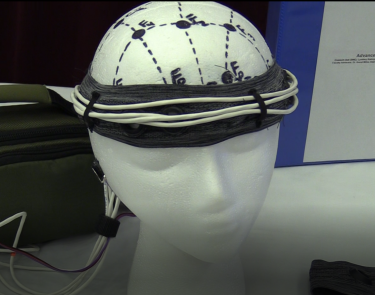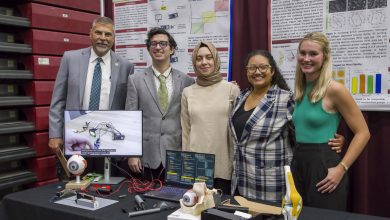Students Design Seizure Predicting Device for Epilepsy Patients
“My grandfather suffered a seizure right before I had to choose my senior design project and had to be closely monitored, but there were no devices that would allow him to be monitored from home,” said Elizabeth Ball, biomedical engineering ’18.
After that experience, Ball, together with her student design team that included; Lyndsey Rohrig, biomedical engineering; Fernando Bendana, computer engineering; Christopher Heath, computer science; Kareem Almari, electrical engineering; and Jamaal Almeen, computer science, designed an EEG and ECG sensor that can predict an oncoming seizure known as ASPIS – Advance Self Protection Integrated System.
ASPIS can monitor patients that suffer from epilepsy or suffered a spontaneous seizure by measuring the electrical activity of the brain as well as the heart.
“One third of the people that suffer from epilepsy still suffer from seizures despite the fact that they take medication, so our goal is to help that group of people recover some of their independence and avoid possible injuries by alerting them that they are about to lose consciousness,” said Ball.
The team was surprised to learn that even though seizure are so common, there aren’t many devices that can predict their onset.
ASPIS is a headband that has sensors symmetrically placed throughout the band with the ECG sensor placed on the ear. The data collected from the sensors is sent via Bluetooth from a raspberry pie to a database. An algorithm then processes the data and if the data points reach a certain threshold, a signal will be sent to a cellphone application. The application can then alert the user of an oncoming seizure. The user can then has time to stop whatever activity they are doing to avoid potential injury. The application can also notify the user’s emergency contact.
The main challenges the team found when designing the device was finding a way to filter out unwanted noise the sensors were picking up. Together Ball and her team were able to overcome that and their sensors were accurate when comparing them with other commercial sensors on the market.
The effectiveness of their algorithm was determined based on the amount “true positives”, “false negatives”, and “false positives” that are detected on seizure data.
“The development of this device, can help people that suffer from this disorder in an affordable and patient friendly manner,” said Ball.





